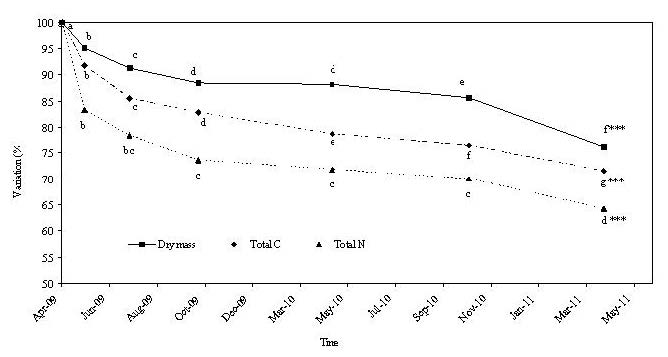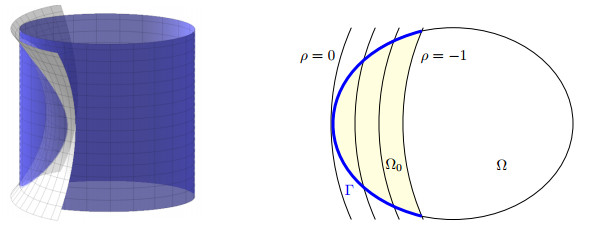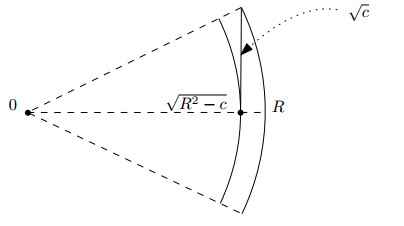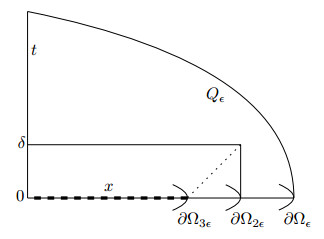1. Introduction
Soil organic matter (OM) plays an important role in long-term soil fertility preservation, due to the improvement of soil physical, chemical and biological properties [1]. However, most of the agricultural soils of the Eastern part of the Po Valley of Italy is showing a low concentration of OM [2], related to the decreased availability of traditional organic fertilizers, the increasing of farm specialization toward fruit tree cultivation [3,4] and the increasing of soil mineralization rates due to soil tillage and warmer climate [5].
The high environmental impact of conventional farming practices has increased interest in strategies that help soil OM preservation such as crop rotations [6], conservative soil tillage systems [7], green manure crops [8] and organic waste application [9]. The production of organic wastes (e.g. municipal activities, farming and agro-industrial processes, animal manures, composted residues, etc.) is increasing worldwide; their disposal processes imply considerable social costs, may be responsible for detrimental environmental impacts and represent a loss of valuable biomass and a sourse of nutrients for crops. The recycling of such biomass in agriculture (e.g. as soil amendments or fertilizers) could represent an interesting way to reduce disposal costs, recycle OM and supply mineral nutrients to the soil [10,11]. The use of by-products from orange processing as fertilizer has been shown to improve soil fertility in an orange orchard [12] and in durum wheat [13]. The mixture of exhausted olive-cake and poultry manure produced an organic fertilizer that improved soil fertility and yield in potato [14]. By-products from the apple processing industry are usually used for the production of pectin [15]; however, they can be potentially treated and used as organic fertilizers.
The aims of this experiment were to evaluate the effect of soil-applied by-products from the apple juice industry in a commercial pear orchard on 1) the dynamics of release of carbon (C) and nitrogen (N) under field conditions; 2) soil fertility; 3) tree growth, yield and nutritional status and 4) fruit quality.
2. Materials and Methods
2.1. Experimental site and plant material
The trial was carried out over three years (2008-2011) in a mature high-density pear (Pyrus communis L.) orchard of cv Abbé Fétel grafted onto quince (Cydonia oblonga Mill.) MC, located on a Haplic Calcisol soil (FAO classification) (Table 1) at the experimental station of Bologna University (Italy, 44°33ʹN; 11°25ʹE).
Table 1. Physical and chemical soil properties.
| Soil parameters | Soil depth (cm) | |
| 0-40 | 40-80 |
| Sand (%) | 8.9 | 7.4 |
| Silt (%) | 51.7 | 53.7 |
| Clay (%) | 39.4 | 38.9 |
| pH | 7.9 | 8.0 |
| Ca carbonate (%) | 2.0 | 3.0 |
| Active lime (%) | 1.0 | 2.0 |
| Organic matter (%) | 1.9 | 1.5 |
| Total N (‰) | 1.4 | 1.1 |
| C/N ratio | 7.9 | 7.9 |
| C.E.C. (meq 100 g-1) | 24.9 | 26.0 |
| Exchangeable K (meq 100 g-1) | 0.5 | 0.4 |
| Exchangeable Ca (meq 100 g-1) | 30.4 | 27.4 |
| Exchangeable Mg (meq 100 g-1) | 3.3 | 2.7 |
Trees were spaced 3.8 m between rows and 0.9 m along rows (2924 trees ha−1) and trained as spindle bush. Irrigation water was daily supplied during vegetative season by drip irrigation, using 3.8 L h−1 emitters, to return moisture lost through evapotranspiration. Tree rows were sprayed with herbicide while the alleys were maintained with a grass cover, which was regularly mown, 4-5 times per year.
The following soil-applied treatments were compared in a randomized complete block design with six replicates: 1) unfertilized control; 2) mineral nitrogen (N) fertilization (60 kg N ha−1 year−1) split in two equal applications (50:50) at petal drop and 40 days after the first application; 3) by-product of apple juice production (AJBP) supplied at a rate of 1.3 t ha−1 year−1 (equal to 60 kg total N), at petal drop; 4) AJBP supplied at a rate of 2.6 t ha−1 year−1 (equal to 120 kg total N) at petal drop. In 2009 and 2010, the rate of N supplied per year was increased to 80 kg ha−1 in treatments 2 and 3 and to 160 kg ha−1 in treatment 4, to satisfy the increased tree N demand according to a higher fruit set. Regarding phosphorus (P), potassium (K) and magnesium (Mg), each plot, including control, was fertilized in order to reach the same amount per hectare and per year. Mineral fertilizer (urea) and AJBP were localized along the tree row and tilled into the top soil (10 cm).
The AJBP, provided by ILSA SpA (Arzignano, Vicenza, Italy), was made from sludge generated by the apple juice industry, after screening, drying, grinding and homogenizing the sludge; chemical characteristics of AJBP used are summarized in Table 2.
Table 2. Physical and chemical properties of apple juice by-product used in the trial.
| Parameter | Value |
| Dry matter (%) | 93.5 |
| Total organic C (%) | 38.1 |
| Total N (%) | 4.5 |
| C/N ratio | 8.5 |
| Total S (SO3) (%) | 2.6 |
| Total P (P2O5) (%) | 1.2 |
| Total K (K2O) (%) | 1.2 |
| Total Ca (CaO) (%) | 1.2 |
| Total Mg (MgO) (%) | 1.0 |
| Total Na (Na2O) (%) | 0.1 |
| Total Fe (%) | 1.5 |
| Total Zn (mg kg-1) | 304 |
| Total Mn (mg kg-1) | 171 |
| Total Cu (mg kg-1) | 163 |
| Total Cr (mg kg-1) | 89 |
| Total Ni (mg kg-1) | 42 |
| Total Pb (mg kg-1) | 33 |
| Total Al (mg kg-1) | 18 |
2.2. Mineralization assay of AJBP
The study was conducted from 2009 to 2011, using the litter bag technique [16,17] to assess the decay dynamics of AJBP. Portions of non-woven fabric were cut and sewn in 18 cm × 18 cm bags; 4 g of apple juice by-product, corrisponding to the amount (in g m−2) of AJBP applied in treatment 3 trees were placed into each bag. Thirty bags in total were prepared and placed on 16 April 2009 along tree row into the soil, at 10 cm depth.
Collection of five bags each sampling time randomly chosen along the row was performed in 2009 on 16 May (+1 month), 16 July (+3 months) and 16 October (+6 months), in 2010 on 13 April (+12 months) and 14 October (+18 months) and in 2011 on 13 April (+24 months). Decomposing AJBP litter was cleaned, oven dried at 65 °C and milled (0.2 mm mesh) for chemical analysis. Concentration of C and N was evaluated by C/N elementar analyser (Carlo Erba, Milan, Italy).
2.3. Soil analysis and microbial C biomass
To evaluate the effect of the treatments on soil fertility, ammonium-N (NH4+-N), nitrate-N (NO3−-N), pH, soil OM, total N, humic and fulvic acids (HA+FA) were measured throughout the experiment. From 2008 to 2010, soil cores were collected 4 times per year at 0-40 cm depth to monitor NH4+-N and NO3−-N concentration before and 40 days after first fertilization, in mid-July and mid-October (3 and 6 months after first fertilization, respectively). Soil NH4+-N and NO3−-N were determined by extracting 10 g of soil with a 2 mol KCl solution (1:10 w/v) [18] and using an auto analyser (Auto Analyzer AA-3; Bran+Luebbe, Norderstadt, Germany). Soil samples collected in October were also analysed for pH, OM, total N [18] and (only in 2010) HA+FA [19].
Microbial C biomass was determined in soil samples taken from a depth of 5-15 cm on the same dates of mineral-N sampling, using the substrate induced respiration method [20]. This involved the sieving (2 mm mesh) of 50 g of fresh soil, placing the screened soil in a 500 mL glass jar and allowing it to equilibrate at room temperature for at least 24 hours. The soil was then mixed with 200 mg of glucose and incubated at 22 °C for 3 hours. Carbon dioxide evolution was measured by an infrared gas analyser (EGM-4; PP system; Hitchin, UK) and converted into microbial C [20].
2.4. Tree performances and nutritional status
The effect of treatments on tree performances was evaluated by measuring, at the end of growing season, trunk cross-sectional area (TCSA) 15-20 cm above the grafting point; tree yield and fruit weight were also determined at commercial harvest. To assess the effect of treatments on tree nutritional status, leaves were sampled in summer from annual shoots, washed, oven dried at 65 °C for 72 h and milled (0.2 mm mesh). At harvest, two slices were taken from each of the 20 fruits of the sample, lyophilized and milled for analyses. Nitrogen was determined by Kjeldahl method [21], while phosphorus was spectrophotometrically quantified at 700 nm after extraction with acid mineralization [22]. Finally, calcium (Ca), K, Mg, iron (Fe), manganese (Mn), zinc (Zn) and copper (Cu) were determined by atomic absorption spectrometry (SpectrAA-200, Varian, Mulgrave, Australia), after acid digestionby a microwave lab station (Ethos TC-Milestone, Bergamo, Italy) [23].
2.5. Fruit quality
At commercial harvest, a representative sample of fruits was collected from each plot and used to determine soluble sugars and organic acids [24] on lyophilized fruit flesh by high performance liquid chromatography (HPLC). Analyses of sugars were performed using a Jasco PU-1580 HPLC (Jasco Inc., Easton, MD, USA) with a refractive index detector Jasco RI-930 (Jasco Inc., Easton, MD, USA), using an Aminex HPX-87-C, 300 × 7.8 mm (Bio-Rad, Hercules, CA, USA) column. The analysis was performed maintaining the column at 85 °C, using ultra pure water as mobile phase, flux at 0.6 mL min−1 while the running time was set at 25 min. Soluble sugars were identified and quantified by the comparison of the retention time with those of standard solutions (Sigma-Aldrich Co. LLC., St. Louis, MO, USA) of known concentration. Soluble organic acids were measured by Jasco PU-1580 (Jasco Inc., Easton, MD, USA) HPLC coupled with a UV-visible detector (MD-1530, Jasco Inc., Easton, MD, USA) using a Phenomenex Rezex ROA-Organic Acid H+ 300 mm × 7.8 mm column (Phenomenex, Torrance, CA, USA). The analysis was performed maintaining the column at 25 °C, using sulphuric acid 0.08M as mobile phase, flux at 0.6 mL min−1 while the running time was set at 25 min. Soluble organic acids were identified and quantified by the comparison of the retention time with those of standard solutions (Sigma-Aldrich Co. LLC., St. Louis, MO, USA) of known concentration.
Antioxidant activity was determined according to Miller [25] evaluating the relative ability of pear flesh to scavenge the radical cation of 2,2ʹ-azinobis 3-ethylbenzothiazoline-6-sulfonate (ABTS+) in aqueous phase in comparison to a standard rate of the synthetic antioxidant 6-hydroxy-2,5,7,8-tetramethylchroman-2-carboxylic acid (Trolox, Sigma-Aldrich, Co., LLC., St. Louis, MO, USA). 0.5 g of lyophilized fruit flesh were added to 20 mL of MeOH (60%), homogenized by ultraturex, centrifuged 15 min at 3000 rpm then 1.5 mL of supernatant was collected. Successively, 196 μL of MeOH (60%) and 20 μL of sample were added to 2 mL of stabilized (0.700 ± 0.010) ABTS+ solution. Absorbances were obtained spectrophotometrically (CPS-240 UV-Visible spectrophotometer, Shimadzu Corp., Kyoto, Japan) after interval of 2ʹ30″ from sample addition at 734 nm.
2.6. Statistical analysis
Data were submitted to analysis of variance as in a complete randomized block design. When analysis of variance showed statistically significant effects of treatments (p £ 0.05), means were separated by the Student Newman Keuls (SNK) test.
3. Results and Discussion
3.1. Mineralization assay of AJBP
The loss of mass during the AJBP decomposition was more rapid during the first 6 months, when about 12% of the original mass was lost; between October 2009 and April 2010 the mass remained relatively stable and the decrease was negligible (Figure 1). During summer 2010 a small but significant decrease of litter mass was recorded (−3% at October sampling), while a consistent and significant mass decrease was measured during winter 2010-2011: after October 2010, the mass decreased by 9.3% and at the end of the study (+24 months after placement) was 76% of initial value (Figure 1). The C and N loss dynamics over the 2 years were similar except in the first month (Figure 1), when the release of N was twice that measured for C (17% and 8% of original amounts, respectively). Starting from the second sampling (+3 months), the dynamic of C and N release showed a similar trend and the amount of nutrient found in the litter gradually decreased untill April 2011 (+2 years after bags placement); at the end of study the C and N still present in the litter were respectively 72% and 64% of the amount originally set (Figure 1). Regarding N, the loss was statistically significant only at the beginning (first 6 months) and at the end (last 6 months) of the trial (Figure 1).
Our findings are partially in agreement with results obtained in a similar study on apple leaves [26]; however, the mass, C and N lost by apple leaves after 2 years were ≥ 50% of initial values, higher than that observed in AJBP litter bags of our experiment. Moreover, the N dynamic found in AJBP litter bags was different than that observed in apple leaves litter, where N concentration in litter constantly increased during the first year after deposition, while decreased slightly only during the second year [26]. The incorporation of external nitrogen in the decomposing litter was observed by other authors and was associated with microbial immobilization of N from external sources [27,28,29].
3.2. Soil parameters
No treatment effects were observed on soil NH4+-N (data not shown). Soil NO3−-N concentrations showed a similar trend during the three-year-study, so that in Table 3 the 3-year averages for each of the four annual sampling dates are reported. In April, before fertilizer application, nitrate-N concentrations were similar (9 to 11 mg NO3−-N kg−1 DW) in all treatments (Table 3). The use of mineral N fertilizer significantly increased NO3−-N availability in May, July and October compared with the control and AJBP treatments (Table 3). Soil nitrate-N availability was fairly even in the absence of fertilizer supply throughout the year. Nitrate concentrations in spring (April-May) ranged between 9 and 10 mg NO3−-N kg−1 DW, while values in summer and autumn were somewhat higher (17-18 mg NO3−-N kg−1 DW) (Table 3) due to nutrient release during the decomposition of soil OM.
Table 3. Effect of fertilization on soil NO3−-N concentration (mg N kg−1 DW) at 0-40 cm depth.
| Treatment | April | May | July | October |
| Control | 10.22 | 9.61 b | 18.2 b | 17.2 b |
| Mineral N | 10.9 | 42.4 a | 81.0 a | 69.5 a |
| AJBP 1.3 t | 10.4 | 13.8 b | 16.2 b | 27.2 b |
| AJBP 2.6 t | 10.2 | 22.5 b | 20.3 b | 33.3 b |
| Significance1 | ns | *** | *** | ** |
1ns, ** and ***: not significant and significant at p < 0.01 and p < 0.001, respectively.
2Average of 2008-2009-2010 yrs. |
The main parameter to quantify the risk of nitrate-N leaching is the concentration of soil nitrate-N at the end of the growing season. In our experiment, fertilization with mineral N resulted in high NO3−-N levels in the soil (70 mg NO3−-N kg−1 DW in the 0-40 cm layer) at the end of the growing season, when tree is entering in the dormancy stage and root uptake is low, and the risk of nitrate leaching is considerable in our conditions [30]; the experimental site, in fact, is located in the Po Valley, a vulnerable zone for nitrate directive. The use of AJBP had no influence on the post-harvest soil nitrate-N and hence did not increase substantially the risk of nitrate leaching during winter [4,31]. The lower nitrate-N concentration observed in AJBP plots than in Mineral N treatment was the consequence of high stability in the soil of the by-product (Figure 1) used in this study; however, the soil amendment could stimulate a development of soil microbial biomass that absorbed part of the mineral N released by the soil OM mineralization process [4,32].
As a matter of fact, the application of apple juice by-product increased microbial C biomass only in 2010 (Table 4), when the application of AJBP at highest rate significantly increased microbial C, compared to the unfertilized plots (Table 4). In May, microbial C was similar in all treatments (data not shown), but in July and October AJBP application significantly increased microbial C compared to the control and mineral N treatment (Table 4). In 2009 and 2011 the organic fertilization did not modify microbial biomass (data not showed). Our results are partially in agreement with literature, which reported that the application of compost [4] and other organic materials [10] can increase soil microbial C. In our study, however, the highest microbial biomass was found in summer, in contrast with those reported by Baldi and co-authors, who found the highest values in spring and autumn [4], because of the different climatic conditions of the two experimental sites.
Table 4. Effect of fertilization strategies on soil pH, organic matter, total N, HA and FA, and microbial C measured in 2010.
| Treatment | pH | OM | Total N | HA+FU | Microbial C (μg C g-1 DW) | |
| | (%) | (‰) | (%) | July | October |
| Control | 7.24 | 1.60 b2 | 1.27 | 0.46 | 239 b | 170 b |
| Mineral N | 6.96 | 1.67 ab | 1.29 | – | 301 ab | 167 b |
| AJBP 1.3 t | 7.28 | 1.83 a | 1.29 | 0.52 | 307 ab | 214 a |
| AJBP 2.6 t | 7.03 | 1.83 a | 1.29 | 0.51 | 366 a | 209 a |
| Significance1 | ns | * | ns | ns | * | * |
1ns and *: not significant and significant at p < 0.05, respectively.
2Within columns, values followed by the same letter are not significantly different (SNK test, p = 0.05). |
Soil pH and total N were unaffected by treatments, but after three years soil amended with AJBP showed higher organic matter concentrations than the control (Table 4). Considering the data of OM concentration at the beginning (Table 1) and at the end of the trial, AJBP has maintained or even increased soil OM, while it decreased significantly in the control and mineral N plots (Table 4). Soil humic and fulvic acid (HA+FA, Table 4) concentrations were not affected by AJBP supply, as expected in a short-term experiment, and ranged between 0.46% (control) and 0.52% (AJBP). Our results are in agreement with other reports [4,33] and confirm that the use of organic residues in horticulture is an effectiveness strategy to preserve and eventually ameliorate soil fertility. In this study, soil OM was maintained with relatively small amounts of organic fertilizer (1.6 t ha−1 in 2009 and 2010) and soil NO3−-N release was compatible with the N requirements for pear orchard, which range between 60 and 80 kg N ha−1 year−1 depending on the graft combination [34,35]. The use of AJBP in pear fertilization can also contribute to soil carbon sequestration, in agreement with literature [4,36,37].
3.3. Tree growth, yield and nutritional status
Tree growth and crop yield were not affected by the different fertilization strategies, as previously published [38]. The absence of significant effects of the N rate on tree growth and yield can be explained by considering the tree age and grafting combination. The use of dwarfing rootstock (i.e. quince MC) and the age of the trees contributed to achieve an optimum balance between tree vigor and production.
Trees fertilized with mineral N showed significantly higher leaf and fruit N concentrations compared with untreated trees, while AJBP treatments showed intermediate values (Tables 5-6). No statistical differences were observed in leaf P, K, Ca and Mg concentrations (Table 5). Regarding fruit mineral composition, trees fertilized with mineral N produced fruits with significantly higher N concentration (0.21%) than unfertilised trees, while K levels (0.50%) were significantly lower (Table 6). Regardless the rate, both fruit and leaves of tree treated with AJBP showed a similar K concentration of control trees. Leaf and fruit micronutrient concentrations were not affected by use of different fertilizer treatments (Tables 5-6).
Table 5. Effect of fertilization strategies on leaf nutrient concentration (means of 3 years).
| Treatment | Macronutrients (% DW) | | | | | Micronutrients (mg kg-1 DW) | | | |
| N | P | K | Ca | Mg | Fe | Mn | Cu | Zn |
| Control | 1.501 b | 0.15 | 0.74 | 1.47 | 0.45 | 95 | 112 | 35 | 101 |
| Mineral N | 1.76 a | 0.15 | 0.61 | 1.50 | 0.49 | 99 | 112 | 35 | 87 |
| AJBP 1.3 t | 1.61 ab | 0.16 | 0.64 | 1.52 | 0.46 | 99 | 122 | 35 | 107 |
| AJBP 2.6 t | 1.65 ab | 0.14 | 0.63 | 1.47 | 0.46 | 99 | 114 | 34 | 106 |
| Significance2 | ** | ns | ns | ns | ns | ns | ns | ns | ns |
1Within columns, values followed by the same letter are not significantly different (SNK test, p = 0.05).
2ns and **: not significant and significant at p < 0.01, respectively. |
Table 6. Effect of fertilization strategies on fruit nutrient concentration (means of 3 years).
| Treatment | Macronutrients | | | | | Micronutrients | | | |
| N | P | K | Ca | Mg | Fe | Mn | Cu | Zn |
| (%) | (‰) | (%) | (‰) | (‰) | (mg kg-1 DW) | | | |
| Control | 0.181 b | 0.56 | 0.56 a | 0.45 | 0.40 | 15 | 3.7 | 2.4 | 9.3 |
| Mineral N | 0.21 a | 0.53 | 0.50 b | 0.47 | 0.35 | 13 | 3.3 | 2.1 | 7.2 |
| AJBP 1.3 t | 0.20 ab | 0.55 | 0.56 a | 0.49 | 0.40 | 16 | 3.7 | 2.1 | 7.8 |
| AJBP 2.6 t | 0.20 ab | 0.55 | 0.55 a | 0.51 | 0.39 | 15 | 3.7 | 2.0 | 10.0 |
| Significance2 | * | ns | * | ns | ns | ns | ns | ns | ns |
1Within columns, values followed by the same letter are not significantly different (SNK test, p = 0.05). Values are the mean of 3 years.
2ns and *: not significant and significant at p < 0.05, respectively. |
Data of leaf mineral composition were generally in line with the reference values considered optimal for cv Abbé Fétel grown in the same area [39], except for N which was below the optimum range (2-2.4%) in all treatments, probably due to the grafting combination, that included the very dwarfing quince MC.
3.4. Fruit quality
Soluble carbohydrates concentrations and organic acids were not increased by mineral or organic N supply (Table 10). Fructose resulted the sugar most abundant in the fruit (32% of DW), followed by glucose and sorbitol (15-20% of DW), and sucrose (less than 5%, Table 7). Regarding organic acids, succinic acid was the most representative (2.3% of DW) followed by malic acid (1.7-2% of DW); citric acid was the least representative, with a concentration ten times lower than the succinic acid (Table 7). The concentration of fruit soluble sugars and organic acids were in agreement with data reported in literature [36,40].
Table 7. Effect of fertilization strategies on fruit soluble carbohydrates and organic acids concentration (means of 2008-2009-2010 yrs.).
| Treatment | Carbohydrates content (g 100 g-1 DW) | | | | Organic acids (g 100 g-1 DW) | | |
| Fructose | Sorbitol | Glucose | Sucrose | Succinic acid | Malic acid | Citric acid |
| Control | 32.4 | 20.1 | 15.7 | 4.22 | 2.36 | 1.91 | 0.21 |
| Mineral N | 32.7 | 19.9 | 18.5 | 3.70 | 2.36 | 1.73 | 0.22 |
| AJBP 1.3 t | 31.4 | 19.0 | 16.5 | 3.75 | 2.22 | 1.74 | 0.22 |
| AJBP 2.6 t | 32.1 | 19.8 | 17.5 | 3.38 | 2.32 | 2.00 | 0.23 |
| Significance1 | ns | ns | ns | ns | ns | ns | ns |
| 1ns: not significant at p< 0.05. |
The antioxidantactivity of fruits, an important aspect for defining fruit quality because of the increasing attention to functional food, was not also modified by treatment in 2008, 2009 and 2010 (Table 8), confirming the low reactivity of fruit crop to soil management in term of fruit composition and functional activity [36,41].
Table 8. Effect of fertilization treatment on fruit antioxidant activity (AA).
| Treatment | AA (mM Trolox g-1 DW) | | |
| 2008 | 2009 | 2010 |
| Control | 31.4 | 51.3 | 54.3 |
| Mineral N | 23.9 | 41.8 | 42.2 |
| AJBP 1.3 t | 36.7 | 36.2 | 38.5 |
| AJBP 2.6 t | 32.5 | 42.9 | 42.7 |
| Significance1 | ns | ns | ns |
| 1ns: not significant at p < 0.05. |
4. Conclusions
Our results indicate that the use of by-products from apple juice production in pear fertilization can be an interesting strategy for maintaining or improving soil OM content and soil fertility. In addition, the use of AJBP promoted soil microorganisms activity, increased soil N availability for plant uptake during the first months after its addition to the soil without increasing the risk of nitrate leaching. At the rates supplied in this study, no effects were observed on tree performances and fruit quality.
Pear fertilization can be managed with the use of organic fertilizers made from fruit processing residues and this study confirms that by-products from the apple juice industry is an effectiveness strategy to preserve soil organic matter and can replace mineral fertilizers as a source of N, without negative effects on tree performances and fruit quality. The recycling of these organic wastes in agriculture can also reduce disposal costs and environmental pollution.
Acknowledgements
Research supported by a grant from Regione Emilia-Romagna and ILSA S.p.A. (Vicenza, Italy). Project ‘Riciclo in frutticoltura di residui di processi agro-industriali’.
Conflict of Interest
All authors declare no conflicts of interest in this paper.









 DownLoad:
DownLoad: 






